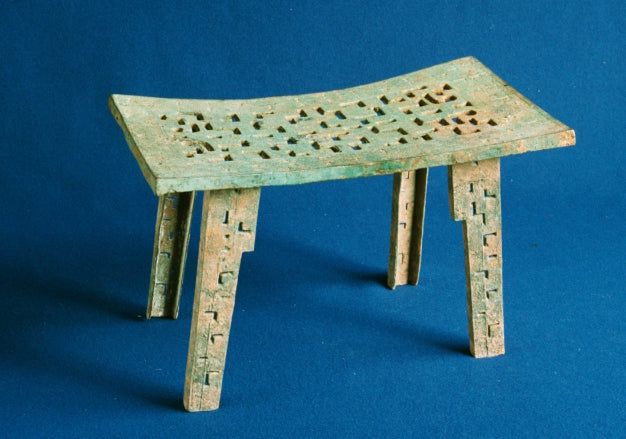
Hollow Dragon Pattern Zu

Hollow dragon-patterned zu, bronze ritual vessel, cultural relic from the Spring and Autumn Period, 35.5 cm long, 21 cm wide, 24 cm high, 3.85 kg, unearthed from Tomb No. 2, Xichuan Xiasi, Nanyang City, Henan Province in 1978.
In the autumn of 1977, the water level of the Danjiang Reservoir, about 50 kilometers south of Xichuan County, Nanyang City, Henan Province, dropped, and a tomb was exposed on the east side of the southern end of Longshan on the west bank of the reservoir. In March of the following year, the Xichuan County Cultural Relics Management Committee sent people to conduct an in-depth investigation of the cemetery, and a total of 24 Spring and Autumn tombs and 8 Han tombs were discovered. In April, the Xichuan County Cultural Relics Management Committee excavated and cleaned the Xichuan Xiasi cemetery, and this hollow cross-dragon pattern zu was unearthed from Tomb No. 2.
The surface of this hollow dragon-patterned zu is slightly concave, in a double "" shape, wide at both ends and slightly narrow in the middle. The four legs are flat, wide at the top and narrow at the bottom, and the cross section is groove-shaped.

Figure 1 Side view of hollow dragon-patterned zu
The evolution of dragon patterns in the pre-Qin period went through a process from concrete to abstract. The early dragon patterns were more concrete, and the dragon patterns gradually became abstract in the late Western Zhou Dynasty. The dragon's horns, eyes, upper and lower jaws, limbs, and dragon scales evolved into S-shaped, C-shaped, long tadpole, rectangular and other geometric patterns, and became stylized patterns. The hollow dragon-patterned zu surface decoration is expressed in two ways: perforation and fine incised lines. There are a total of 42 perforations on the hollow dragon-patterned zu surface, located in the center of the zu surface. The eight rectangular perforations in the middle divide the perforations of the square ruler, L-shaped, and rounded corner folding ruler into two groups. The eight square ruler-shaped and L-shaped perforations respectively constitute the dragon's nose and upper and lower jaws, front and rear limbs, horns, ears, back and tail. The hollow dragon-patterned zu has two groups of deformed dragon patterns on its surface, with the dragon heads facing outward and the four tails gathered in the center of the zu. Because the bronze zu surface is high on both sides and concave in the middle, the dragon heads are higher than the dragon tails, giving people a sense of rising. The finely carved patterns can be divided into three types: one is the fine cloud-thunder pattern decorated between the 42 holes; the second is the coiled snake pattern decorated at the narrow end of the zu surface; and the third is the wave-shaped pattern band decorated at the wide end of the zu surface. The flat foot of the hollow dragon-patterned zu is also decorated with a deformed dragon pattern, and the holes are filled with fine coiled snake patterns.

Figure 2 The evolution of dragon head patterns in the Shang and Zhou dynasties

Figure 3 Schematic diagram of the perforated dragon pattern on the surface of the hollow dragon-patterned zu
The zu is designed with eight perforated dragon patterns, four on the zu surface and one on each of the four flat feet, but they are opposite to each other and echo each other. The four dragons on the top of the table and the four dragons on the flat feet form a pair of dragon patterns that echo each other. In terms of the overall layout of the patterns, this table embodies the design concept of multi-angle symmetrical design (that is, today's four-square continuous pattern design).


![8.3"China Shang Dynasty,Bronze wine cup [Fuhao Jue cup][妇好爵杯]](http://bronzc.com/cdn/shop/files/4ee0482982cfa89bb4d1cff3333a55e6_e3ca0b86-22fc-497d-9afd-578c551225a3-2.jpg?v=1733986652&width=533)

![12.8" China Ming Dynasty, Phoenix-patterned bronze vase[Ming Wanli Phoenix-patterned vase][明万历凤纹瓶]](http://bronzc.com/cdn/shop/files/4ee0482982cfa89bb4d1cff3333a55e6_a516991b-2bb9-4b2f-a2b6-4354129d006c.jpg?v=1733986953&width=533)

![14.6" China Eastern Han Dynasty Bronze vessel in the shape of a flying horse,Also known as bronze galloping horse[Horse Stepping on Flying Swallow][马踏飞燕]](http://bronzc.com/cdn/shop/files/4ee0482982cfa89bb4d1cff3333a55e6_aa3fbeb8-e08b-4a44-929a-13411ca8fb17-2.jpg?v=1733987211&width=533)

![5.9"China Tang Dynasty, Bronze of a walking dragon[Tang Walking Dragon][唐走龙]](http://bronzc.com/cdn/shop/files/2_8cb416b9-ebbd-4fe2-a905-b9277f820c16.png?v=1731488701&width=533)
